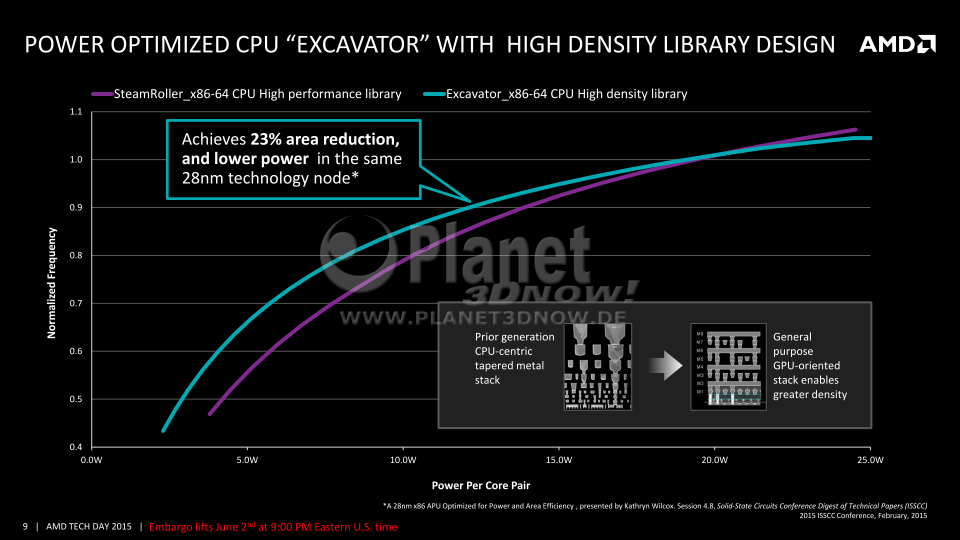At 20nm SOI or 14nm FF I would sure would like an 8-Core Excavator, not at 28nm though.
Actually, the new GV-A1 stepping would make it somewhat-tolerable. Or you could use the same process variant used in Carrizo, depending on what you wanted.
Consider Carrizo. It has superior voltage scaling with clockspeed to GV-A1 Kaveri up to about 2.5 GHz. Beyond that, GV-A1 Kaveri is better, thanks to HDL on Carrizo and all that.
At speeds of 2.5 GHz, Carrizo burns up maybe 42W when strapped to a 500-600 MHz 512-shader GCN iGPU. Eliminate the iGPU and replace it with two more XV modules. The die size should be smaller, and your power usage is probably going to be in the 50-70W range. Bear in mind that's a 4M/8T chip at 2.5 GHz. Add in Carrizo's more-sophisticated-than-Kaveri power management, and you could get some fairly sophisticated turbo settings on that chip. It would be a low-price competitor to Broadwell-D. The performance/watt would be inferior, but it would be better than the empty void that AMD has on the market right now.
Or, consider XV with the same refinements put into the GV-A1 stepping (assuming some/all of those refinements are applicable; that may be an erroneous assumption). XV should exhibit similar/identical voltage scaling as compared to GV-A1 Kaveri in that configuration. They could probably get a 4m/8t XV running around 3.4 GHz in a TDP of maybe 80-100W. I'm leaning closer to 80W but maybe I'm just being optimistic. Again, many would point out that such a part might not be competitive with (insert name of Intel CPU here), but it's better than the gaping void in the AMD lineup out there right now. The only problem I see with this particular scenario is that the die size might be too great.
What you would not get is something like a 4m/8t XV chip hitting 5 GHz with power consumption lower than that of PD at the same clockspeed. You probably wouldn't see clocks over 4.5 GHz with any degree of reliability. It would be a non-starter for most enthusiasts. AMD would have to position the product elsewhere.
That being said, AMD has too few resources and too little time to bring such a product to market. Hindsight is 20/20. Had AMD known how Carrizo would turn out, or had they known how GV-A1 stepping would affect Steamroller, maybe they could have started work sometime last summer on a stopgap XV solution with simplified power planes vs. Carrizo (read: no iGPU) that would work on AM3+. I do not think AM4 is ready, and with 2016 being so close to the Zen launch, I don't think they want to invest in a 4m XV chip that would launch with AM4.
AMD would be better served in getting an EX core APU into AM4 (or whatever zen's platform will be called) with a proper die shrink down to 14/16FF along with whatever new graphics AMD has planned for that node. 2017 is a long ways off.
I agree with that, though again, there is a question of what it is they can do with their remaining resources and talent. The Zen team seems to be sucking up all the oxygen these days. It would make sense to port XV to GF's 14nm as a test-case.
I don't even think you will see socket Carrizo either. AMD's only real new product in 2016 might be Arctic Islands.
If we see anything from AMD, it will probably be 28nm Bristol Ridge launching AM4 in Q3 2016. Zen follows up in Q4 2016 with limited supply and/or Q1 2017 in greater quantity . . . assuming AMD lasts that long.




